How to use the VALUE function
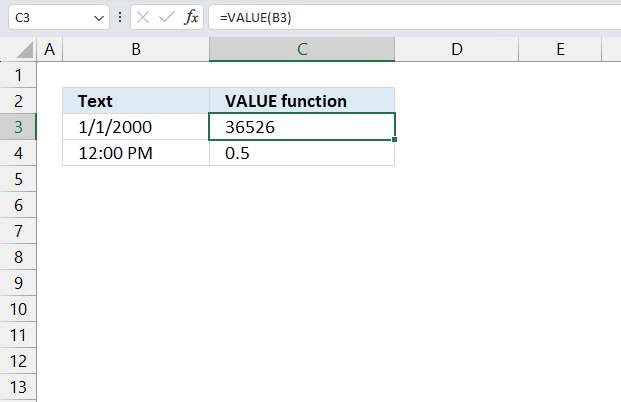
What is the VALUE function?
The VALUE function converts a text string that represents a number to a number.
Table of Contents
1. Introduction
Why is the VALUE function needed?
This function is included for compatibility with other software. Imported data from other software may cause values like numbers, dates, and times to be misidentified as text values in Excel.
The VALUE function is rarely needed in Excel formulas, since text is automatically converted to numbers where required.
What other functions in Excel are included for compatibility with other software?
T function - returns a text value if the argument is a text value.
N function - returns a numerical value if the argument is a number.
VALUETOTEXT function - returns a value in text form.
ARRAYTOTEXT function - concatenates values from a given cell range or array using the comma and/or semicolon as delimiters, the result is a text string.
Why convert date, time and number values from text to numerical values?
Converting to the appropriate data types makes it easier to calculate with, visualize, analyze, and store efficiently in Excel. Keeping numbers, times, and dates as text severely limits Excel's full capabilities.
- Enables calculations, text strings prevent any computations.
- Allows date/time functions to work properly. Valid date serial numbers are required, not text strings.
- Avoids sorting issues. Converting to numbers allows correct sort order.
- Saves storage space. Numeric formats are more compact than text formats, especially for large data sets.
- Enhances performance. Formulas with value conversions slow down spreadsheets.
2. Syntax
VALUE(text)
The VALUE function has only one argument.
| text | Required. The number stored as a text string you want to be converted to a number. |
3. Examples
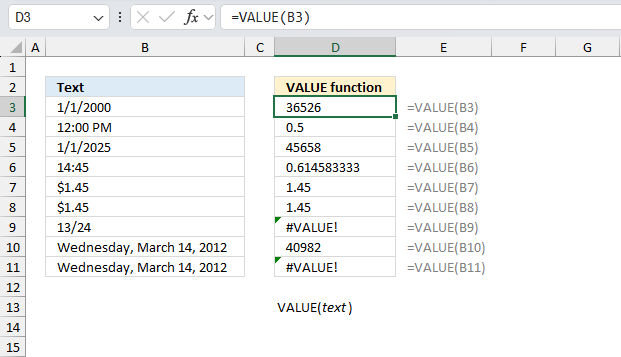
The VALUE function attempts to convert text that represents numbers in a recognized format into actual numbers. It works with various formats including dates, times, percentages, and currency. When it encounters a format it doesn't recognize or can't convert, it returns a #VALUE! error.
Cell B3 contains a date identified as a text value, this may cause problems if we try to perform calculations to this date. Excel needs dates as numbers in order to properly perform date calculations.
Formula in cell D3:
The formula in cell C3 converts the text date string "1/1/2000" into a numeric date serial number in Excel. Dates in Excel are stored as serial numbers representing the number of days since January 1st, 1900. The date serial number for January 1st, 2000 is 36526 (the 36,526th day since 1900-01-01).
Formula in cell D4:
The source data in cell B4 is "12:00 PM" and the result is 0.5 The function converts the time string to its decimal representation (fraction of a day).
Formula in cell D5:
The source data in cell B5 is "1/1/2025" and the result in cell D5 is: 45658 The function converts the date string to its numeric representation.
Formula in cell D6:
The source value in cell B6 is "14:45", and the result in cell D6 is: 0.614583333 The function converts the time string to its decimal representation.
Formula in cell D7:
The source data in cell B7 is "$1.45" and the result in cell D7 is: 1.45 Explanation: Removes the currency symbol and converts the string to a number.
Formula in cell D8:
The source data in cell B8 is "$1.45" and the result is 1.45 Explanation: Same as D7, removes currency symbol and converts to number.
Formula in cell D9:
The source data in cell B9 is "13/24" and the result is #VALUE! Explanation: Error because "13/24" is not recognized as a valid number or date format.
Formula in cell D10:
The source data in cell B10 is "Wednesday, March 14, 2012" and the result is: 40982 Explanation: Converts the long date string to its numeric representation.
Formula in cell D11:
The source data in cell B11 is "Wednesday, March 14, 2012" and the result is: #VALUE! Explanation: Error, because this specific long date format is not recognized by the VALUE function in this Excel setup.
4. Example 2 - filter converted values
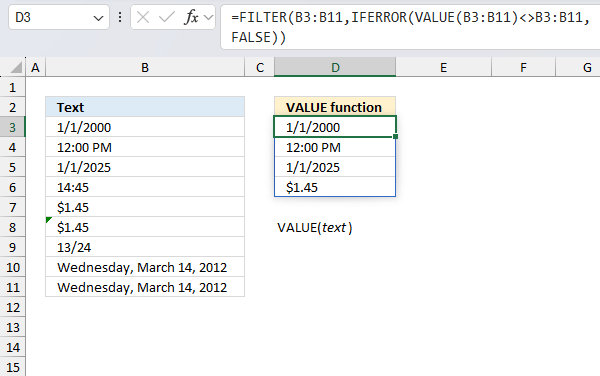
The formula in cell D3 shown in the image above filters converted values from cell range B3:B11, in other words, values are filtered if the VALUE function converts text values to their numerical representation.
Cell range B3:B11 contains values, some are text values and some are regular numbers formatted as dates, times or currency.
Formula in cell D3:
The formula in cell D3 extracts values in cells B3, B4, B5, and B7 because they are text values that the VALUE function successfully converts to their numerical representation.
Explaining formula
Step 1 - Convert values in B3:B11 to their numerical equivalents
VALUE(B3:B11)
becomes
VALUE({"1/1/2000"; "12:00 PM"; "1/1/2025"; 0.614583333333333; 1.45; "$1.45"; "13/24"; 40982; "Wednesday, March 14, 2012"})
and returns
{36526; 0.5; 45658; 0.614583333333333; 1.45; 1.45; #VALUE!; 40982; #VALUE!}
Step 2 - Value to value comparison
The less than and larger signs allow you to check if a value is not equal to another value. The result is a boolean value TRUE or FALSE which the FILTER function in step 4 can use to extract the appropriate values.
VALUE(B3:B11)<>B3:B11
becomes
{36526; 0.5; 45658; 0.614583333333333; 1.45; 1.45; #VALUE!; 40982; #VALUE!}<>{"1/1/2000"; "12:00 PM"; "1/1/2025"; 0.614583333333333; 1.45; "$1.45"; "13/24"; 40982; "Wednesday, March 14, 2012"}
and returns
{TRUE; TRUE; TRUE; FALSE; FALSE; TRUE; #VALUE!; FALSE; #VALUE!}
These values contain error values, we need to convert the errors to boolean value FALSE since we don't want the filtered.
Step 3 - Handle errors
The IFERROR function if the value argument returns an error, the value_if_error argument is used. If the value argument does NOT return an error, the IFERROR function returns the value argument.
Function syntax: IFERROR(value, value_if_error)
IFERROR(VALUE(B3:B11)<>B3:B11,FALSE)
becomes
IFERROR({TRUE; TRUE; TRUE; FALSE; FALSE; TRUE; #VALUE!; FALSE; #VALUE!},FALSE)
and returns
{TRUE; TRUE; TRUE; FALSE; FALSE; TRUE; FALSE; FALSE; FALSE}
Step 4 - Filter values based on boolean array
The FILTER function extracts values/rows based on a condition or criteria.
Function syntax: FILTER(array, include, [if_empty])
FILTER(B3:B11,IFERROR(VALUE(B3:B11)<>B3:B11,FALSE))
becomes
FILTER(B3:B11, {TRUE; TRUE; TRUE; FALSE; FALSE; TRUE; FALSE; FALSE; FALSE})
and returns
{"1/1/2000"; "12:00 PM"; "1/1/2025"; "$1.45"}
5. Function not working
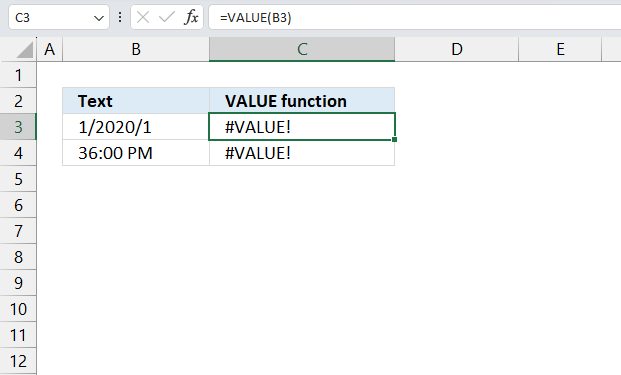
The VALUE function can only convert text formatted as standard number, date or time strings that Excel can identify. Any other text format will result in a #VALUE! error.
Cell B3 contains a date that Excel can't recognize, the VALUE function returns a #VALUE! error.
The VALUE function returns a #SPILL! error if cells below are not empty, delete the cell contents and the VALUE function should work properly.
5.1 Troubleshooting the error value

When you encounter an error value in a cell a warning symbol appears, displayed in the image above. Press with mouse on it to see a pop-up menu that lets you get more information about the error.
- The first line describes the error if you press with left mouse button on it.
- The second line opens a pane that explains the error in greater detail.
- The third line takes you to the "Evaluate Formula" tool, a dialog box appears allowing you to examine the formula in greater detail.
- This line lets you ignore the error value meaning the warning icon disappears, however, the error is still in the cell.
- The fifth line lets you edit the formula in the Formula bar.
- The sixth line opens the Excel settings so you can adjust the Error Checking Options.
Here are a few of the most common Excel errors you may encounter.
#NULL error - This error occurs most often if you by mistake use a space character in a formula where it shouldn't be. Excel interprets a space character as an intersection operator. If the ranges don't intersect an #NULL error is returned. The #NULL! error occurs when a formula attempts to calculate the intersection of two ranges that do not actually intersect. This can happen when the wrong range operator is used in the formula, or when the intersection operator (represented by a space character) is used between two ranges that do not overlap. To fix this error double check that the ranges referenced in the formula that use the intersection operator actually have cells in common.
#SPILL error - The #SPILL! error occurs only in version Excel 365 and is caused by a dynamic array being to large, meaning there are cells below and/or to the right that are not empty. This prevents the dynamic array formula expanding into new empty cells.
#DIV/0 error - This error happens if you try to divide a number by 0 (zero) or a value that equates to zero which is not possible mathematically.
#VALUE error - The #VALUE error occurs when a formula has a value that is of the wrong data type. Such as text where a number is expected or when dates are evaluated as text.
#REF error - The #REF error happens when a cell reference is invalid. This can happen if a cell is deleted that is referenced by a formula.
#NAME error - The #NAME error happens if you misspelled a function or a named range.
#NUM error - The #NUM error shows up when you try to use invalid numeric values in formulas, like square root of a negative number.
#N/A error - The #N/A error happens when a value is not available for a formula or found in a given cell range, for example in the VLOOKUP or MATCH functions.
#GETTING_DATA error - The #GETTING_DATA error shows while external sources are loading, this can indicate a delay in fetching the data or that the external source is unavailable right now.
5.2 The formula returns an unexpected value

To understand why a formula returns an unexpected value we need to examine the calculations steps in detail. Luckily, Excel has a tool that is really handy in these situations. Here is how to troubleshoot a formula:
- Select the cell containing the formula you want to examine in detail.
- Go to tab “Formulas” on the ribbon.
- Press with left mouse button on "Evaluate Formula" button. A dialog box appears.
The formula appears in a white field inside the dialog box. Underlined expressions are calculations being processed in the next step. The italicized expression is the most recent result. The buttons at the bottom of the dialog box allows you to evaluate the formula in smaller calculations which you control. - Press with left mouse button on the "Evaluate" button located at the bottom of the dialog box to process the underlined expression.
- Repeat pressing the "Evaluate" button until you have seen all calculations step by step. This allows you to examine the formula in greater detail and hopefully find the culprit.
- Press "Close" button to dismiss the dialog box.

There is also another way to debug formulas using the function key F9. F9 is especially useful if you have a feeling that a specific part of the formula is the issue, this makes it faster than the "Evaluate Formula" tool since you don't need to go through all calculations to find the issue..
- Enter Edit mode: Double-press with left mouse button on the cell or press F2 to enter Edit mode for the formula.
- Select part of the formula: Highlight the specific part of the formula you want to evaluate. You can select and evaluate any part of the formula that could work as a standalone formula.
- Press F9: This will calculate and display the result of just that selected portion.
- Evaluate step-by-step: You can select and evaluate different parts of the formula to see intermediate results.
- Check for errors: This allows you to pinpoint which part of a complex formula may be causing an error.
The image above shows cell reference B3 converted to hard-coded value using the F9 key. The VALUE function requires valid values which is not the case in this example. We have found what is wrong with the formula.
Tips!
- View actual values: Selecting a cell reference and pressing F9 will show the actual values in those cells.
- Exit safely: Press Esc to exit Edit mode without changing the formula. Don't press Enter, as that would replace the formula part with the calculated value.
- Full recalculation: Pressing F9 outside of Edit mode will recalculate all formulas in the workbook.
Remember to be careful not to accidentally overwrite parts of your formula when using F9. Always exit with Esc rather than Enter to preserve the original formula. However, if you make a mistake overwriting the formula it is not the end of the world. You can “undo” the action by pressing keyboard shortcut keys CTRL + z or pressing the “Undo” button
5.3 Other errors
Floating-point arithmetic may give inaccurate results in Excel - Article
Floating-point errors are usually very small, often beyond the 15th decimal place, and in most cases don't affect calculations significantly.
Can the VALUE function handle arrays?
Yes, it can handle arrays.
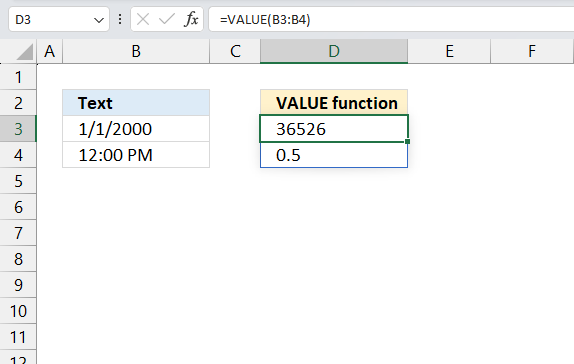
Useful resources
VALUE function - Microsoft support
What is the VALUE Function?
Functions in 'Text' category
The VALUE function function is one of 29 functions in the 'Text' category.
How to comment
How to add a formula to your comment
<code>Insert your formula here.</code>
Convert less than and larger than signs
Use html character entities instead of less than and larger than signs.
< becomes < and > becomes >
How to add VBA code to your comment
[vb 1="vbnet" language=","]
Put your VBA code here.
[/vb]
How to add a picture to your comment:
Upload picture to postimage.org or imgur
Paste image link to your comment.
Contact Oscar
You can contact me through this contact form